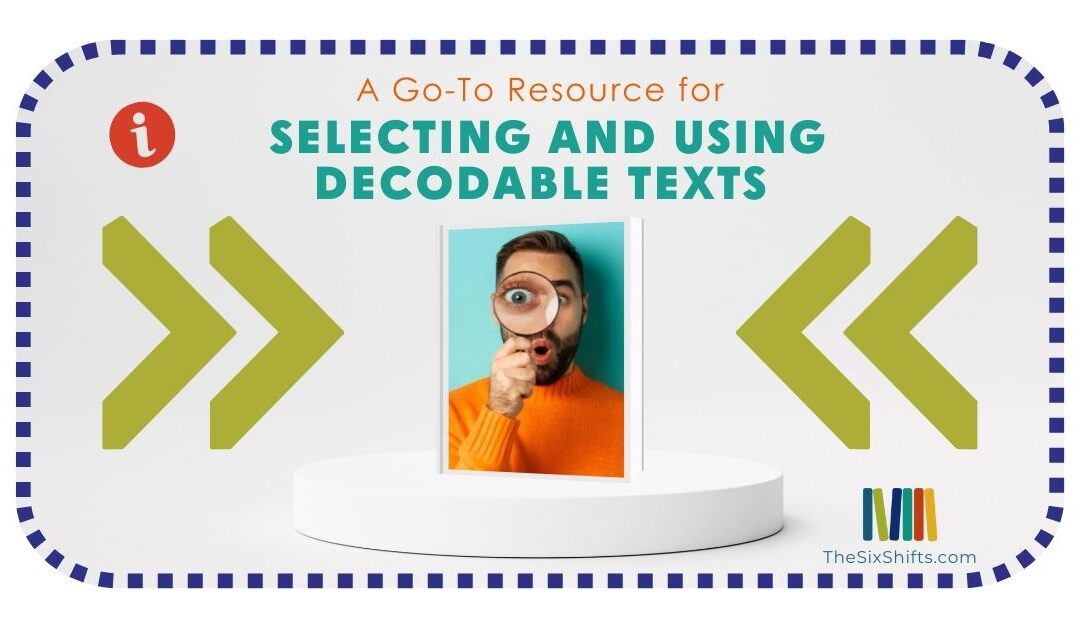Talk of decodable texts is everywhere these days. And if you’re like many educators we know, you might be working to sort through the hype to make sense of it all.
We’ve written a lot about decodable texts—exploring their significance, selection criteria, creative implementation strategies, and much more.
Our goal is always to provide practical insights and resources to enhance literacy instruction. We want to help you both understand (theory) and take action (implementation). Of course, much of our writing is based on common questions we receive from educators like you who are trying to make sound decisions about instructional materials.
Each brief summary below contains a link to one of our previous posts about using decodable texts. Across these posts, we unpack important considerations and common questions related to decodable texts and their role in supporting young readers.
This May Not Be Everything You Need to Know About Decodable Texts, but It’s A Lot of it!
What Is Decodable Text?
Wondering what makes a decodable text decodable? Or maybe you’re trying to clarify who really needs decodable texts, anyway. In this introduction, we tackle fundamental questions about what makes a text decodable after all. We lay the groundwork for deeper explorations of the topic, which you will find in other posts linked in this index. [Read more.]
How Many Decodable Texts Are Enough?
In this post, we consider the question of quantity when it comes to decodable texts. This post includes insights and considerations to help educators make informed decisions about how many decodable texts they need to effectively support beginning readers. [Read more.]
What to Look For When Choosing Decodable Texts—The WORDS
In this post, our focus shifts to the composition of decodables. Here, we offer guidance for evaluating the mix of words (decodable, high frequency, and content or story words) within decodable texts. This post equips you to think deeply about the ways the words in a decodable text do (or don’t) align with the practice your beginning readers need. [Read more.]
What Else to Look For When Choosing Decodable Texts—The MEANING
In this segment, we explore the significance of another critical consideration for decodable text selection: the meaning-making possibilities the text offers. (Yes, meaning matters in a decodable text!) While decoding skills are crucial, we also emphasize the importance of engaging students in meaningful reading experiences because teaching students to read without attending to the meaning behind the words is a recipe for developing word-callers. Read to learn how to select decodable texts that foster comprehension and meaningful engagement, even when the demands of decoding the words are controlled. [Read more.]
What About FREE Decodable Books and Texts?
Who doesn’t love free resources? In this post, we describe affordable and accessible ways to gather decodable texts. From digital platforms to printable materials, we share resources that educators can leverage to enhance their decodable text collections, regardless of budget restraints. Of course, you’ll need to look closely at them to make sure they hold up when it comes to aligned decoding and meaning-making opportunities. [Read more.]
More Ideas for Getting Started with Decodable Text
In this post, we provide educators with ideas and strategies for incorporating decodable texts across the school day. From interactive games to independent practice activities, we offer practical ideas to seamlessly weave decoding practice into the day. [Read more.]
A Free Decodable Text in Three Different Formats
After sharing a page from this text in our K-2 Shifting the Balance book, we received so many requests for the whole text that we made it available as a free resource. In this post, you will find links to three different formats of A Pup Can: a digital flip book for projecting and sharing with students, a downloadable PDF with directions for printing in a book format, and a one-pager for student follow-up practice. [Read more.]
Explore these additional resources to continue your journey into practical uses of decodable texts.
Decodable Word Lists and Sentences
Explore practical ways to utilize two sets of decodable word lists and sentences introduced in a previous post. We suggest seven ideas for incorporating these resources into teaching, including supplementing a phonics curriculum, providing blending practice in various settings, dictating sentences for spelling and formative assessment, and creating decodable passages for reading practice. These strategies aim to support educators in making reading instruction more effective and accessible for students.
Adjustments to Small Group Instruction: Part 1 and Part 2
Discover how revisiting and refining small group instruction practices can enhance the use of decodable texts, offering a personalized approach to support foundational reading skills in a dynamic classroom environment.
Leveraging Decodable Texts in Flexible Phonics Lessons
This guide emphasizes the critical role of decodable texts in flexible phonics instruction, offering insights on how to seamlessly integrate these resources into lessons tailored to meet diverse learner needs and promote comprehensive reading development.
Whether you’re just beginning to explore decodable texts or you want to refine your selection process, we hope this collection of posts provides insights and resources that support your journey as you hold fast to your commitment to making learning to read easier for your students.




Looking forward to explore this more!
The link to the post about how to use Decodable Texts across the school day doesn’t work. I would love some help with how to use decodable texts as our school has many but the teachers haven’t used them because they are not yet comfortable with them.
Hi Melanie. Which link isn’t working? You might find what you are looking for on our Decodable Texts Content Corner.